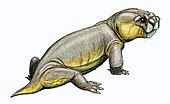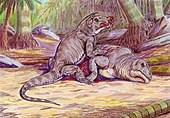Paleontology or palaeontology is the study of prehistoric life forms on Earth through the examination of plant and animal fossils.[1] This includes the study of body fossils, tracks (ichnites), burrows, cast-off parts, fossilised feces (coprolites), palynomorphs and chemical residues. Because humans have encountered fossils for millennia, paleontology has a long history both before and after becoming formalized as a science. This article records significant discoveries and events related to paleontology that occurred or were published in the year 1938.
Dinosaurs
New taxa
| Name | Novelty | Status | Authors | Age | Type locality | Location | Notes | Images |
|---|---|---|---|---|---|---|---|---|
| "Antarctosaurus jaxarticus"[2] | Nomen nudum | Riabinin | Santonian | Dabrazinskaya Svita | An informal species of Antarctosaurus | |||
| "Bactrosaurus prynadai"[2] | Nomen nudum | Riabinin | Santonian | Dabrazinskaya Svita | A species of Bactrosaurus, formally described in 1939 | |||
| "Jaxartosaurus aralensis"[2] | Nomen nudum | Riabinin | Santonian | Dabrazinskaya Svita | A hadrosaurid, formally described in 1939 |
Synapsids
Non-mammalian
| Name | Novelty | Status | Authors | Age | Type strata | Location | Notes | Images |
|---|---|---|---|---|---|---|---|---|
|
Valid |
Broom |
 | ||||||
|
Valid |
Boonstra |
|||||||
|
Valid |
Broom |
|||||||
|
Valid |
Broom |
 | ||||||
|
Valid |
Broom |
 | ||||||
|
Valid |
Efremov |
 | ||||||
|
Valid |
Riabinin |
 |
Mammals
| Name | Novelty | Status | Authors | Age | Type Strata | Location | Notes | Images |
|---|---|---|---|---|---|---|---|---|
|
Gen. et. sp. nov. |
Jr Homonym |
Wood |
Eocene |
The type species is C. totadentata. |
 | |||
|
Valid |
 | |||||||
|
Sp nov |
Valid |
Pleistocene |
 | |||||
|
Gen et sp nov |
Valid |
Eocene |
The type species is S. mongoliensis |
 | ||||
|
Valid |
 |
References
- ^ Gini-Newman, Garfield; Graham, Elizabeth (2001). Echoes from the past: world history to the 16th century. Toronto: McGraw-Hill Ryerson Ltd. ISBN 9780070887398. OCLC 46769716.
- ^ a b c Riabinin, A.N. (1938). "Некоторые Результаты Изучения Верхнемеловой Динозавровой Фауны Из Окрестностей Ст. Сары-агач В Южном Казахстане" [Some results of the studies of the Upper Cretaceous dinosaurian fauna from the vicinity of the station Sary-Agach, South Kazakhstan]. Problems of Paleontology. 4: 125–135.
- ^ a b Broom, R. (1938). "On two new anomodont genera" (PDF). Annals of the Transvaal Museum: 247–250.
- ^ Broom, R. (October 1938). "20. On a New Family of Carnivorous Therapsids from the Karroo Beds of South Africa". Proceedings of the Zoological Society of London. B108 (3): 527–533. doi:10.1111/j.1469-7998.1938.tb08528.x. ISSN 0370-2774.
- ^ Wood, Horace Elmer (December 30, 1938). "Cooperia totadentata, a remarkable rhinoceros from the Eocene of Mongolia". American Museum Novitates (1012): 1–20. hdl:2246/2209.
- ^ a b c Kretzoi, M. (1938). "Die Raubtiere von Gombaszög nebst einer Übersicht der Gesamtfauna (Ein Beitrag zur Stratigraphie des Altquartärs)". Annales Musei Nationalis Hungarici. 31. Budapest: Hungarian Natural History Museum: 88–157.
- ^ Granger, Walter (April 21, 1938). "A giant oxyaenid from the Upper Eocene of Mongolia. American Museum novitates; no. 969". American Museum Novitates (969): 1–5. hdl:2246/2199.








